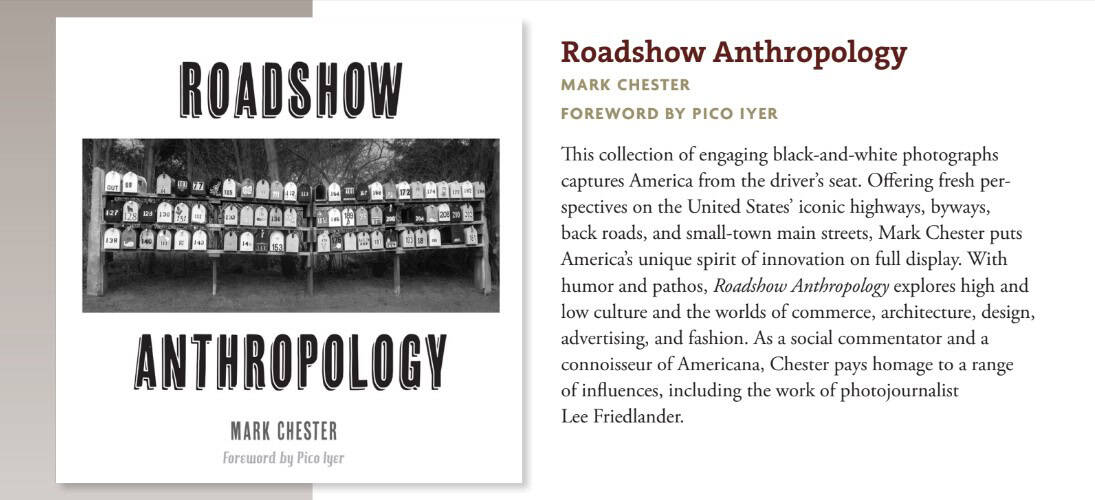The Importance of Inclusive Restroom Signage
Professional photographer Mark Chester did not intentionally find the issue of inclusivity in restroom access – the issue found him. Chester began photographing restroom signs 12 years ago. In conducting this work, Chester began pondering the relationship between signage and inclusivity. What he found is that the barriers to equitable restroom access for people across the gender identity spectrum are all reflected in the evolution of bathroom signs.
The Importance of Inclusive Restroom Signage
by Mark Chester
To paraphrase Pete Seeger, “Where have all the restrooms gone? Long time searching.”
The first thing I do when visiting and walking in a new city is to scope out a public restroom or where one might be available in a private setting, such as a restaurant or hotel or municipal building. With tamped down security in today’s environment, finding one seems more difficult, especially with legislation restricting access for the LGBTQ+ population. Finding a bathroom presents hurdles. And not being able to find a public restroom can create a personal emergency.
For more than 12 years now, I have been documenting unique restroom gender signs. They are a vast collection of quirky art -- drawings, painting, sculptures of wood and wire -- posted on the doors to the restroom in restaurants, movie theaters, public buildings, business offices, anywhere. They’re clever, whimsical renderings showing the female and male, or objects that allude to femininity and masculinity, such as a man’s and woman’s shoe adhered to the door, or a shaving brush, razor, bar of lather and set of pearls, lipstick, and a wilted rose from the prom.
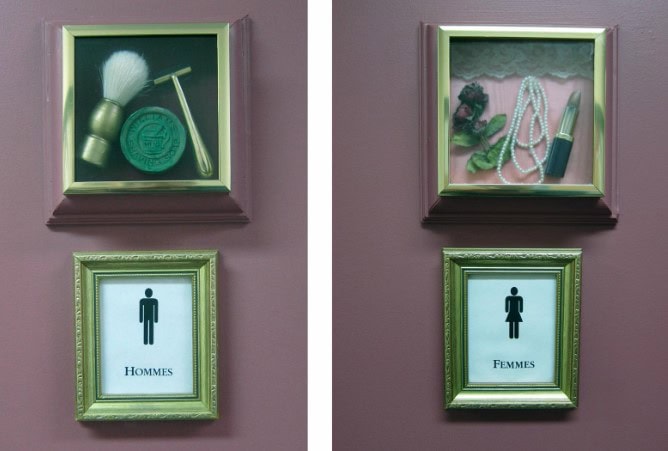
An artistic rendition of gendered restroom signs from a restaurant in Massachusetts. The French for men (hommes) and women (femmes) is used. These signs feature objects traditionally used by “men” and “women” in the restroom, such as a mustache brush, razor, and shaving lather bar for men and lipstick, wilted roses (of a corsage), and a pearl necklace for women.
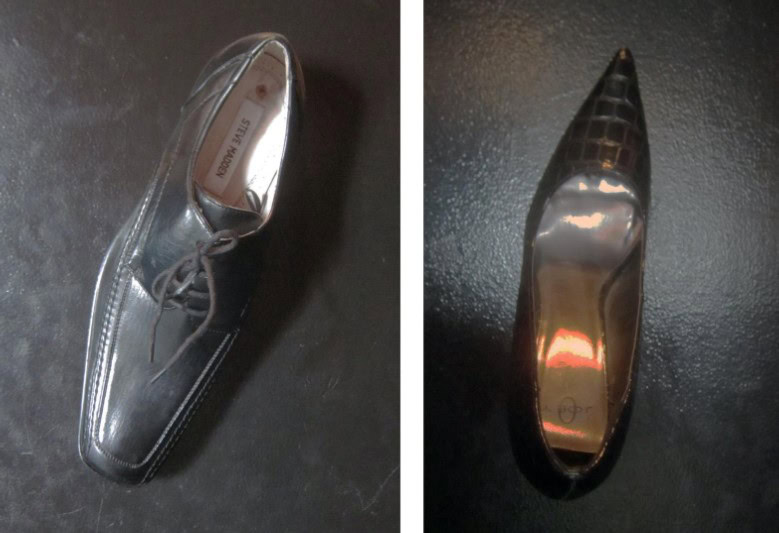
A more subtle example of gendered restroom signs, from a restaurant in Arizona. These signs are simply dress shoes traditionally designated “men’s” and “women’s.” The idea adds a unique and creative element to the restroom experience. However, due to the increasing fluidity of gender expression (i.e. shoe types being worn across the gender spectrum), this signage is becoming obsolete and may be considered confusing to some customers.
Yet more recently, an increasing number of signs have proclaimed to be all-inclusive, welcoming all forms of gender identity, irrespective of sex at birth. Or, to put it simply: “Whatever!” If a restroom is well-planned and offers the privacy and features necessary for anyone to use the restroom, then by all means, hop on board and proudly state it!
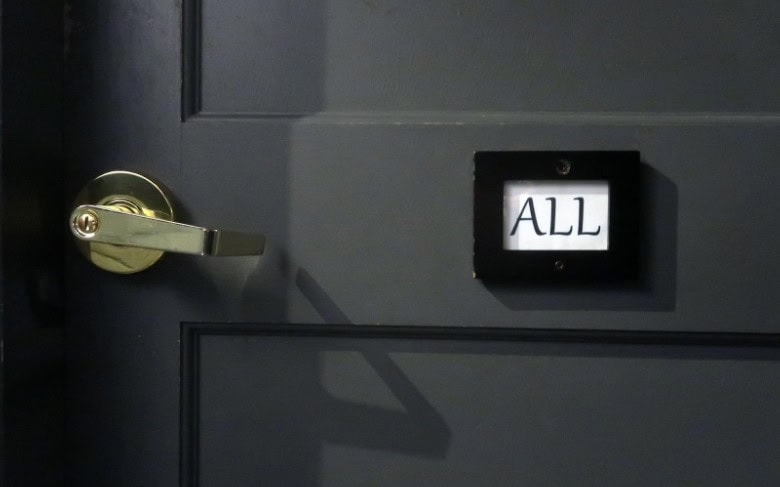
A simple sign indicating that any are allowed to use this restroom, from a restaurant in New Bedford, Massachusetts. The word “ALL” gets the point across. This is a single-user restroom, which makes it much easier to implement for all-inclusive uses.
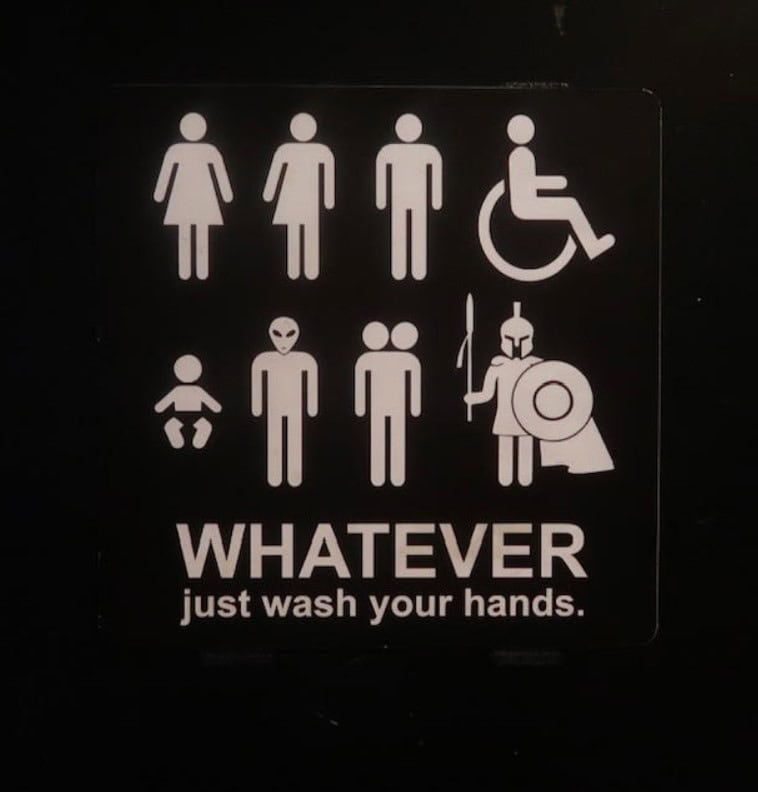
A sign for an all-user restroom in Providence, Rhode Island, which attempts to be humorous by including aliens, a two-headed person, and knights among the figures. It simply states “WHATEVER – just wash your hands.”
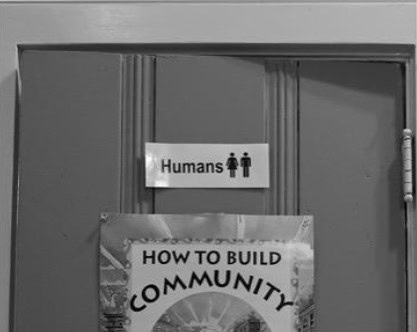
A simple sign stating the facility is for “Humans” to use (although featuring the standard gendered icons). This sign is from a nonprofit restroom in Boston. Below the sign is a poster with good suggestions for “How to Build Community.”
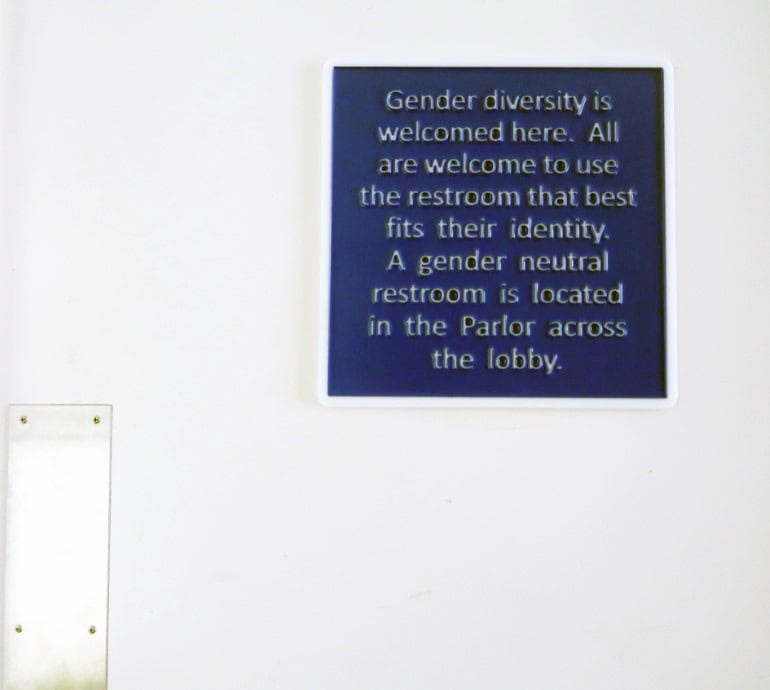
A sign respectfully presenting the inclusivity of the corresponding restroom at a Unitarian Universalist Church in Massachusetts. This sign states that “Gender diversity is welcomed here. All are welcome to use the restroom that best fits their identity. A gender neutral restroom is located in the Parlor across the lobby.”
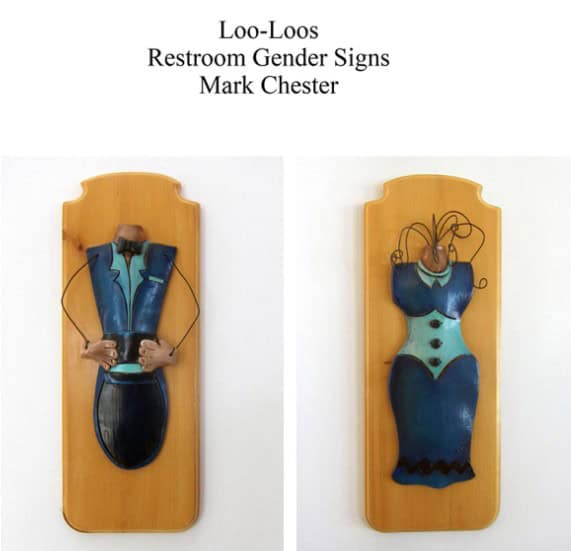
The cover for Chester’s forthcoming book, Loo-Loos: Restroom Gender Signs. It features an artfully crafted sign using wire and painted wood to depict traditionally "feminine" and "masculine" figures.
In documenting these images, the idea for a new book came about. The book, titled Loo-Loos: Restroom Gender Signs, is an anthropological index which offers a fun and surprising perspective. It is a timely take on the significant social issue of gender identity and all-inclusive public restrooms through an artistic lens; inclined to humor, sometimes silliness, with an eye on human nature; the relationships between and among humans; and societal and cultural exchange.
I find the signs in the collection to be clever, elegant, colorful, and corny. They are made of ceramic, paper, wire, and wood. Some are plastic or painted in pastel or colored pencil. Some have vintage photographs and prints. All are unique and thought-provoking. They're inviting.
The accomplished author, writer and humorist, Roy Blount, Jr. has written an introduction to the book. Currently, I am seeking an interested publisher or literary agent. Contact makchester31@gmail.com if interested - thank you.
More public restrooms are necessary for all, including those of all gender identities, the physically, mentally, and medically challenged, those of all races and creeds, body sizes, and ages. And ideally, with simple, clear signage (although all-encompassing humor is always welcome, too). Just think: how can we move to legislate inclusive restrooms, just as we were able to establish the ADA (Americans with Disabilities Act) of 1990)? This journey and contemplation have inspired me to write an opinion for my local paper reflecting upon the Civil Rights Act and my personal experiences with the transgender community, including an assignment to photograph Caitlin Jenner during her Olympic heyday (prior to her transition).
The mission and vision of PHLUSH is simple:
Through education and advocacy, PHLUSH helps local governments and citizens groups to provide equitable restroom availability and to prepare for sanitation disasters with appropriate ecological toilet systems. Total availability is a human right and well-designed sanitation systems restore health to our cities, our waters, and our soils.
What I’ve gleaned from discovering these colorful, original restroom gender icons is that owners or managers of restaurants, cinemas, bus and train stations, airports, and other properties that serve the public provide a safe and clean sanitation facility for all their customers, as should be without discrimination of gender identity. We all have the same human need which must be addressed and resolved by having hundreds -- no, thousands more public sanitation outlets. Seeing artful signs instead of the manufactured boring “Men” or “Women” sign brings an awareness to the universal concept of a restroom and the fact that there may not be many others nearby. The signs in a subtle, effective way remind us of the importance and need for many more restrooms made available in town squares, community parks and other common locations where the public congregates.
I support the mission and vision of PHLUSH. Making public restrooms available to everyone is more than a necessity, it is a mandate for better health. All of us can be a part of the bigger picture of public restroom design and access by advocating for more inclusive facilities in our own community -- and artful, all-inclusive restroom gender signs are a fun part of the bigger picture.
Mark Chester
Cape Cod, Massachusetts
MARK CHESTER is a Cape Cod–based photographer and journalist. His work is in permanent museum collections nationwide. Read more about his upcoming publication, Roadshow Anthropology, below.
